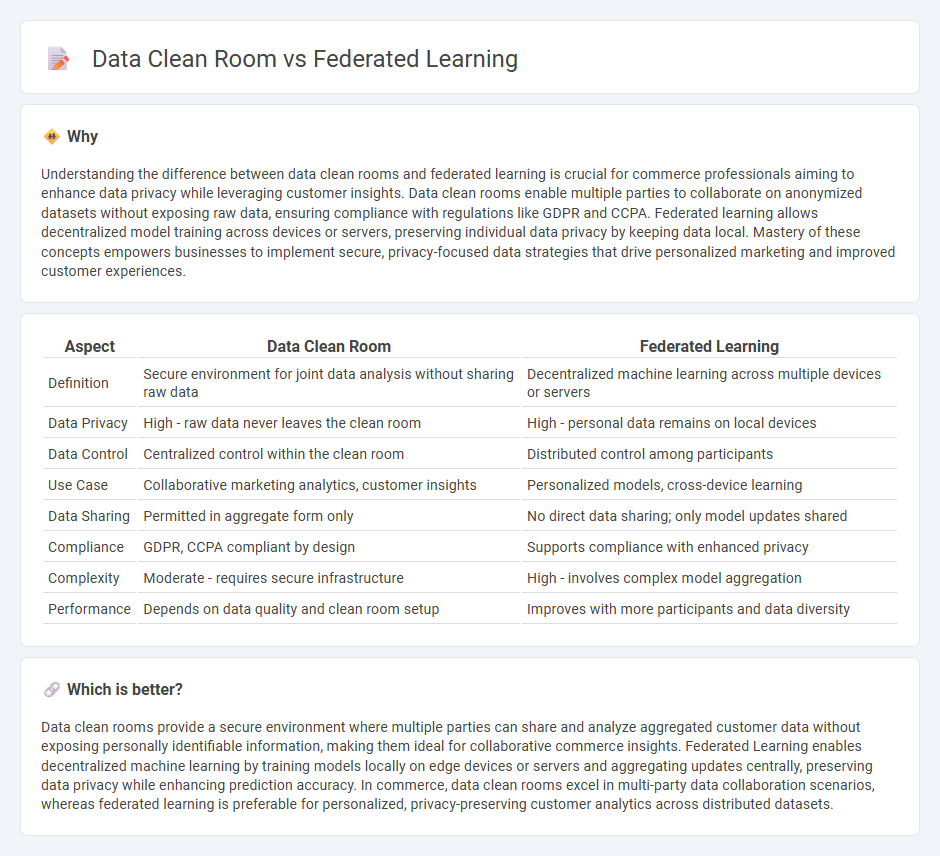
Data clean rooms enable multiple organizations to securely share and analyze combined data sets without exposing raw data, ensuring compliance with privacy regulations such as GDPR and CCPA. Federated Learning allows decentralized model training across diverse local data sources, enhancing data privacy by keeping data on individual devices while collaboratively improving machine learning models. Explore further to understand how both technologies revolutionize secure data collaboration in commerce.
Why it is important
Understanding the difference between data clean rooms and federated learning is crucial for commerce professionals aiming to enhance data privacy while leveraging customer insights. Data clean rooms enable multiple parties to collaborate on anonymized datasets without exposing raw data, ensuring compliance with regulations like GDPR and CCPA. Federated learning allows decentralized model training across devices or servers, preserving individual data privacy by keeping data local. Mastery of these concepts empowers businesses to implement secure, privacy-focused data strategies that drive personalized marketing and improved customer experiences.
Comparison Table
| Aspect | Data Clean Room | Federated Learning |
|---|---|---|
| Definition | Secure environment for joint data analysis without sharing raw data | Decentralized machine learning across multiple devices or servers |
| Data Privacy | High - raw data never leaves the clean room | High - personal data remains on local devices |
| Data Control | Centralized control within the clean room | Distributed control among participants |
| Use Case | Collaborative marketing analytics, customer insights | Personalized models, cross-device learning |
| Data Sharing | Permitted in aggregate form only | No direct data sharing; only model updates shared |
| Compliance | GDPR, CCPA compliant by design | Supports compliance with enhanced privacy |
| Complexity | Moderate - requires secure infrastructure | High - involves complex model aggregation |
| Performance | Depends on data quality and clean room setup | Improves with more participants and data diversity |
Which is better?
Data clean rooms provide a secure environment where multiple parties can share and analyze aggregated customer data without exposing personally identifiable information, making them ideal for collaborative commerce insights. Federated Learning enables decentralized machine learning by training models locally on edge devices or servers and aggregating updates centrally, preserving data privacy while enhancing prediction accuracy. In commerce, data clean rooms excel in multi-party data collaboration scenarios, whereas federated learning is preferable for personalized, privacy-preserving customer analytics across distributed datasets.
Connection
Data clean rooms enable multiple commercial entities to securely collaborate and analyze shared customer data without exposing sensitive information, ensuring compliance with privacy regulations. Federated Learning complements this by allowing decentralized machine learning models to be trained across multiple data sources within clean rooms, preserving data privacy while enhancing predictive analytics in commerce. Together, they revolutionize data-driven decision-making in retail, marketing, and e-commerce by combining privacy-preserving techniques with collaborative insights.
Key Terms
Privacy-preserving computation
Federated learning enables decentralized model training by keeping data localized on user devices, ensuring privacy through encrypted model updates instead of raw data sharing. Data clean rooms facilitate secure data collaboration by allowing multiple parties to perform joint analysis on combined datasets without exposing individual-level information, using strict access controls and anonymization techniques. Explore detailed comparisons to understand which privacy-preserving computation method suits your organization's data security requirements best.
Data collaboration
Federated Learning enables data collaboration by allowing multiple parties to train a shared machine learning model without exchanging raw data, preserving privacy while improving insights across decentralized datasets. Data clean rooms provide a secure environment where organizations can combine and analyze anonymized data collaboratively, ensuring compliance with privacy regulations and minimizing data exposure. Explore how these innovative approaches redefine secure data collaboration and drive smarter analytics.
User-level data control
Federated learning enables user-level data control by processing data locally on user devices, minimizing data exposure and enhancing privacy through decentralized model training. Data clean rooms provide a secure environment for aggregating and analyzing user data without revealing individual-level information, ensuring strict data governance and compliance. Explore how these approaches differ in preserving user privacy and data control to better implement privacy-centric data strategies.
Source and External Links
What Is Federated Learning? | IBM - Federated learning is a decentralized machine learning approach where nodes train a global model on their local data without sharing sensitive information, preserving privacy by aggregating updates on a central server rather than centralizing data itself.
What is federated learning? - Federated learning enables multiple participants to collaboratively train a single AI model by training on private local data and sharing only encrypted updates with a central server, supporting various strategies such as horizontal, vertical, and transfer federated learning.
Federated learning - Wikipedia - Federated learning trains machine learning models over decentralized, heterogeneous datasets on local nodes by exchanging model parameters (not raw data) to build a shared global model, differing from traditional distributed learning in its dataset assumptions and client reliability.
 dowidth.com
dowidth.com